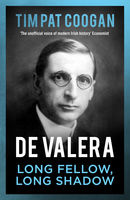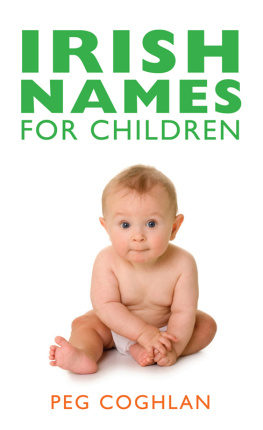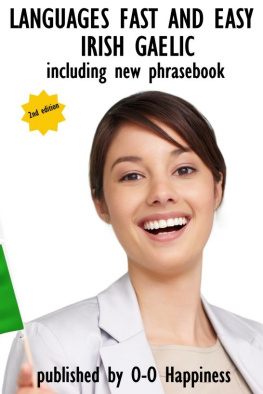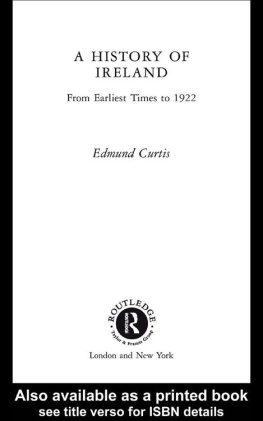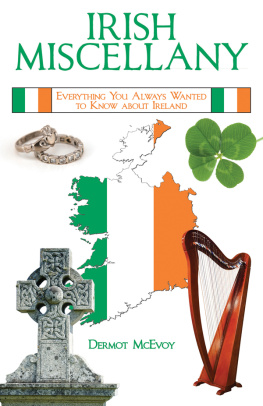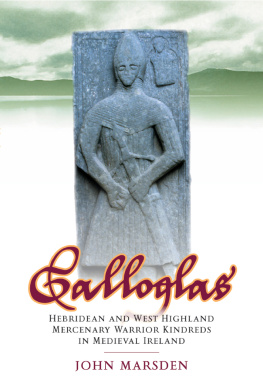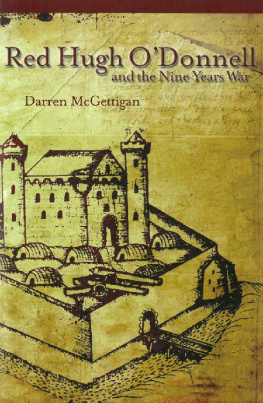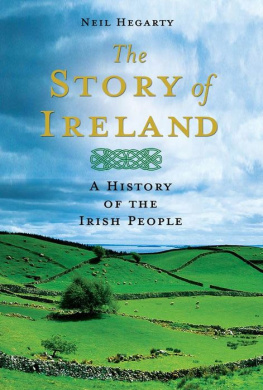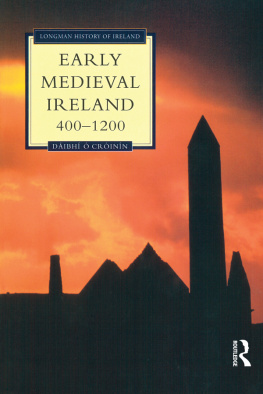It is perhaps a measure of the then neglect of research into the autonomous regions of Gaelic and Gaelicized Ireland in the later medieval period which for Ireland can be taken as extending down to the completion of the English conquest in 1603 that the first edition of this book, when it appeared in 1972, should have attracted such attention and that it has continued to exercise a great deal of influence, to judge by its frequent citation, in writings on the period. This was in spite of its being, as I admitted in the Preface to that first edition, no more than an interim report on my continuing research, of its being without references, in places badly expressed, and in others severely abridged by considerations of space imposed by the publisher. A new edition has been long overdue.
In spite of these weaknesses, and since I have seen no reason to change substantially any of the major conclusions, or indeed opinions, expressed in it, I have made as few changes as possible for the present edition. An exception is Chapter 6, of which the greater part has been completely rewritten and expanded. I have also greatly expanded a number of other sections, notably those on law and institutions, to make precise in the light of subsequent research what had been vague or doubtful, or, in two cases, to restore material dropped from the first edition for considerations of space. Excisions have been minimal. Those comparing the two editions will also notice some slight and perhaps some not so slight! changes of emphasis.
This book consists of two distinct parts. The first section is devoted to a general account of the society and institutions of Gaelic and Gaelicized Ireland during the later middle ages, so far as the available evidence permits us to reconstruct them. The available materials on the economic condition of the country are unfortunately so scanty that no adequate picture can be drawn and I have designedly left aside literature and art, partly from consideration of space but principally because these aspects, unlike the political and legal structure, have been already the subject of a considerable degree of published work. Some other sections, especially on the Church, have been regretfully omitted due to exigencies of space: I hope to publish some material on them elsewhere. The second portion of the work consists of a brief history of those regions of Ireland outside the control of the English administration during the same period.
Both sections of this work, with the exception of a few short paragraphs on specialised matters, are based almost entirely on original research, largely among unprinted sources, a fact which creates a number of problems for a work of a popular nature without footnotes or critical apparatus.
If one might coin an epigram, Gaelic Ireland in its later period has been as unfortunate in its historiography as it was in its history. Not only has there been a destruction of source material perhaps unparalleled in western Europe, when one adds to the destruction of the Irish Public Records in 1922 the destruction of private archives which has continued unabated down to the present day, but the subject itself, the history and institutions of Gaelic Ireland during its latest period, has been left almost entirely untouched by those who have concerned themselves with the history of Ireland. A few schematic generalisations, grounded not in research on the sources but on deductions from the conditions of an earlier age, have too often been the substitute for a detailed investigation of the actual society itself. That neither the society and institutions of late medieval Ireland nor the individual history of the various regions has up to now been the subject of a work of scholarly value might seem surprising to anyone unacquainted with the limitations of Irish historiography, especially when he notes that what seemed to have been a promising beginning had been made in the early and mid-nineteenth century. The explanation must be sought in a number of causes, not all of them in the world of learning, but certainly a most important factor in this neglect was the dichotomy which developed and still exists in Ireland between the fields of historical and Celtic studies.
The present work could therefore be described in the words used with infinitely less justification than in the present instance by Professor Otway-Ruthven to describe her HistoryofMedievalIreland, as an interim report on my work on Gaelic and Gaelicized Ireland, its society and institutions . The popular work has in this case come before the learned monograph; for the defects which must necessarily arise from this inversion of the normal order, as well as for the imbalance which considerations of space have imposed in certain parts, I beg the readers forbearance.
I must express my gratitude to Dr Gearid Mac Niocaill, who drew my attention to some slips in my original draft of chapters 2 and 3.
The Crown copyright material quoted in this work appears by permission of the controller of Her Majestys Stationery Office.
K.W.Nicholls,July1971
Ireland has suffered in its historiography through its geographical position. At the western extremity of Europe, Ireland so far as the native Gaelic world was concerned was yet outside the typical European social milieu, and its analogies must in many ways be sought outside western Europe. To take a glaring example, Christianity in medieval Ireland never seems to have really expanded outside the purely religious sphere of life. In this respect Ireland may be compared the comparison does not originate with me with another land at the extremity of Christendom, Ethiopia (Abyssinia). There, likewise, Christianity seems not to have succeeded in imposing its impress on the whole social system, as it did in both Latin and Orthodox Christendom. In Ireland and in Ethiopia alike, to take a notorious example, marriage and divorce (in practice if not in theory) tended to be determined by secular rules quite different from the teachings of the Church on these matters. Again, the principle of lineage or clan expansion, vital to an understanding of medieval Ireland, has no parallel elsewhere in Europe, outside the other Celtic lands of Wales and Scotland, although identical phenomena can be seen in many parts of Asia and Africa where, as in Ireland , a lineage system prevailed.
It has been customary to depict medieval Ireland as sharply divided into two worlds, the test of division being whether the ruling family in a particular area was of pure Gaelic or of Anglo-Norman origin. In fact it was not so. If we leave aside the Pale, where conditions might be said to have approximated to those of the northern border counties of England, although becoming increasingly penetrated by Gaelic influences in the fifteenth and sixteenth centuries, the cultural picture of later medieval Ireland was very much the same, varying only in degree. If the Gaelic lordships of Ulster, remote from foreign influence, had retained the greatest degree of resemblance to conditions before the invasion of 1169, those of Munster were very different. If in the Anglo-Norman areas of Munster law and custom were a mixture of Irish and English forms and the rule of primogeniture was still generally, if not invariably, observed, the lordships of Anglo-Norman descent in Connacht and Westmeath would to an outside observer have appeared indistinguishable from their purely Gaelic neighbours, with whom they practised succession by tanistry and inheritance of land by Irish gavelkind. The notion that late medieval Ireland was sharply divided on the basis of the national origin of the ruling lineages is one which cannot survive an investigation of the actual facts.


